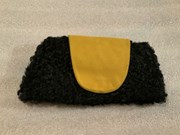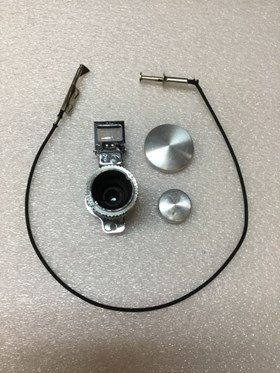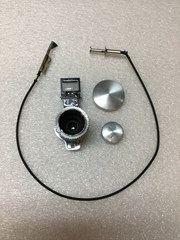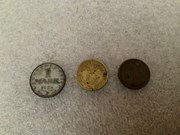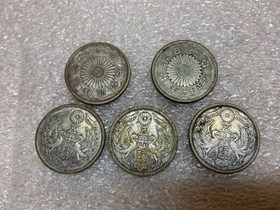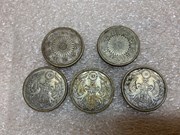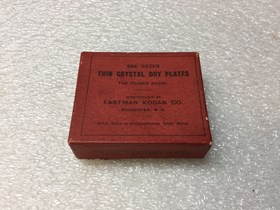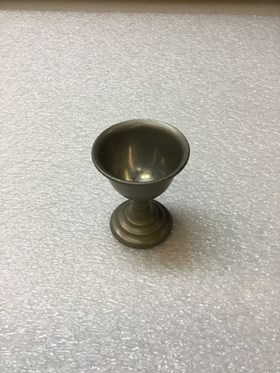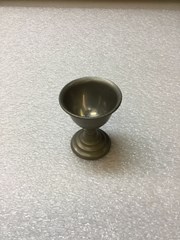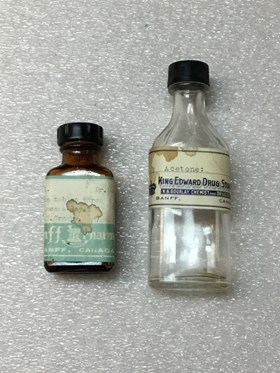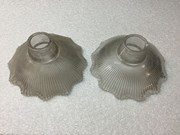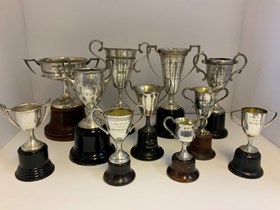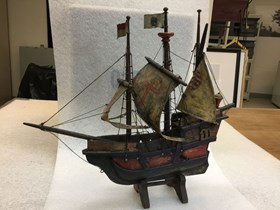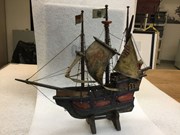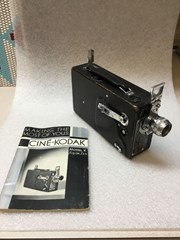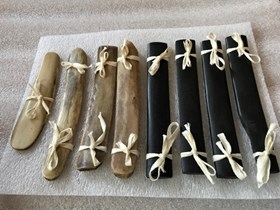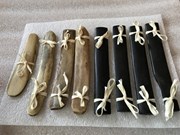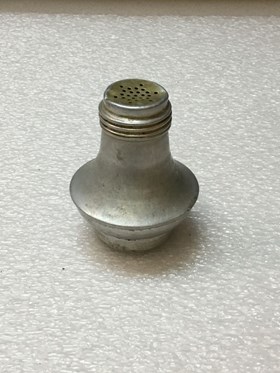Narrow Results By
- Date
- 1920 – 1950
- Material
- hair, sheep; fibre
- Catalogue Number
- 103.04.0011
- Description
- A rectangular, narrow, straight sided hat of curly black lamb's wool. There is a crease down the centre of the crown, and a yellow wool flap that attaches to each side with hook snaps. The hat has a quilted black satin lining.
1 image
- Title
- Astrakhan
- Date
- 1920 – 1950
- Material
- hair, sheep; fibre
- Dimensions
- 15.0 x 4.0 x 28.5 cm
- Description
- A rectangular, narrow, straight sided hat of curly black lamb's wool. There is a crease down the centre of the crown, and a yellow wool flap that attaches to each side with hook snaps. The hat has a quilted black satin lining.
- Subject
- winter
- social customs
- Credit
- Gift of Pearl Evelyn Moore, Banff, 1979
- Catalogue Number
- 103.04.0011
Images
This material is presented as originally created; it may contain outdated cultural descriptions and
potentially offensive content.
Read more.
- Date
- c. 1930
- Material
- paper; plastic;
- Catalogue Number
- 104.41.0246
- Description
- A small black plastic camera, Univex Model A, in its original box with information sheet. The box is bright orange with black text and stripes along the box. Front of the box has an illustration of the camera in the top middle, with text surrounding that reads “UNIVEX PICTURES MAKE” “BEAUTIFUL ENLA…
1 image
- Title
- Camera
- Date
- c. 1930
- Material
- paper; plastic;
- Dimensions
- 6.6 x 9.1 x 5.0 cm
- Description
- A small black plastic camera, Univex Model A, in its original box with information sheet. The box is bright orange with black text and stripes along the box. Front of the box has an illustration of the camera in the top middle, with text surrounding that reads “UNIVEX PICTURES MAKE” “BEAUTIFUL ENLARGEMENTS”. Underneath the illustration in cursive text “Univex” and in regular text “A JEWEL OF A CAMERA” and in the bottom black stripe, “UNIVERSAL CAMERA CORPORATION” “MADE IN U.S.A.” “NEW YORK, N.Y.”. This is the same on the opposite side. Along the shorter side is more text “MODEL A” “Univex” “CAMERA”, a stamp that reads “UNIVERSAL CAMERA COMPANY HERMANT BLOG. TORONTO, — CANADA”, and “MADE IN U.S.A.” The top and bottom of the box just read “MODEL A” “Univex” “CAMERA”. Inside the box is a small information sheet with pricing of rolls for the camera, printing and developing. The camera is small with a long square lens, a metal wire range finder that lines up with the smaller range finder attached to the side of the camera. The shutter is one the side of the lens, fairly small. There is a metal knob to wind the film. The back of the camera features raised text, “Univex” “USE UNIVEX No 00 FILM ROLLS ONLY” in a square, a red circle with “MADE IN UNITED STATES OF AMERICA”, “MODEL A CAMERA U.S. PAT. DES. 89.88 OTHER U.S. AND FOR’G’N PATSPOG” in a square, and “UNIVERSAL CAMERA CORPORATION NEW YORK, N.Y., U.S.A.”. The inside of the camera has a spot for film.
- Credit
- Gift of Don Harmon, Banff, 1985
- Catalogue Number
- 104.41.0246
Images
This material is presented as originally created; it may contain outdated cultural descriptions and
potentially offensive content.
Read more.
Camera Accessories
https://archives.whyte.org/en/permalink/artifact104.41.0185%20a%2cb
- Date
- 1923 – 1940
- Material
- metal; glass; fabric;
- Catalogue Number
- 104.41.0185 a,b
- Description
- Silver metal Kodak lens with mounting plate that includes a fold-up view finder [possibly for a Ciné-Kodak motion picture camera] with black velvet-lined lens caps and a black fabric-wrapped extension trigger for an unknown camera.
1 image
- Title
- Camera Accessories
- Date
- 1923 – 1940
- Material
- metal; glass; fabric;
- Dimensions
- 4.2 x 4.1 x 9.6 cm
- Description
- Silver metal Kodak lens with mounting plate that includes a fold-up view finder [possibly for a Ciné-Kodak motion picture camera] with black velvet-lined lens caps and a black fabric-wrapped extension trigger for an unknown camera.
- Credit
- Gift of Robert Crosby Family, Banff, 1998
- Catalogue Number
- 104.41.0185 a,b
Images
This material is presented as originally created; it may contain outdated cultural descriptions and
potentially offensive content.
Read more.
Canadian Blue Ensign Flag
https://archives.whyte.org/en/permalink/artifact109.02.1015
- Date
- 1921 – 1957
- Material
- fabric; rope; metal
- Catalogue Number
- 109.02.1015
- Description
- A fabric Canadian Blue Ensign flag with a metal hook attached to the top left corner and a metal loop attached to a rope, attached to the bottom left corner. The main colour of the flag is royal blue. A red, white and blue union flag occupied the top left quarter. In the top right quarter, is a Coa…
1 image
- Title
- Canadian Blue Ensign Flag
- Date
- 1921 – 1957
- Material
- fabric; rope; metal
- Dimensions
- 44.0 x 94.0 cm
- Description
- A fabric Canadian Blue Ensign flag with a metal hook attached to the top left corner and a metal loop attached to a rope, attached to the bottom left corner. The main colour of the flag is royal blue. A red, white and blue union flag occupied the top left quarter. In the top right quarter, is a Coat of Arms of Canada, characterized by its five sections: the three golden lions on red; the single red lion on gold; the golden harp on blue; the three golden fleur de lis on blue; and the three green maple leaves on white.There is a manufacturer’s label stitched on the top-left edge, reading: MADE BY/ S.S. HOLDEN / LTD./ OTTAWAThis text is red and appears within a red drawing of what looks like a tent’s side.Below this label, the black letters BR are stamped onto the fabric.
- Credit
- Gift of Brian Wing, Calgary, 2015
- Catalogue Number
- 109.02.1015
Images
This material is presented as originally created; it may contain outdated cultural descriptions and
potentially offensive content.
Read more.
- Date
- 1925 – 1950
- Material
- metal; aluminum; wood;
- Catalogue Number
- 104.19.0272
- Description
- Tall cylindrical aluminum coffee maker/pot with an ventilation cap that fits on top and an internal filter. The main body has a wooden handle screwed into one side, with a short spout opposite it - throughout the portion of the coffee maker that is covered by the spout are small holes. The cap has …
1 image
- Title
- Coffee Maker
- Date
- 1925 – 1950
- Material
- metal; aluminum; wood;
- Dimensions
- 27.5 x 11.2 x 19.1 cm
- Description
- Tall cylindrical aluminum coffee maker/pot with an ventilation cap that fits on top and an internal filter. The main body has a wooden handle screwed into one side, with a short spout opposite it - throughout the portion of the coffee maker that is covered by the spout are small holes. The cap has two roughly-triangular groupings of ventilation holes opposite from each other and the domed top is capped with a small wooden handle. Inside the coffee maker is a metal filter that consists of a thin pole supported by a slightly domed base with a lip just above the middle on which sits the removable filter. No manufacturer details could be found.
- Subject
- coffee maker
- drinks
- kitchen utensil
- Credit
- Gift of Bill Mather, Edmonton, 1991
- Catalogue Number
- 104.19.0272
Images
This material is presented as originally created; it may contain outdated cultural descriptions and
potentially offensive content.
Read more.
- Date
- 1924 – 1938
- Material
- metal
- Catalogue Number
- 109.03.0016 a-c
- Description
- Three German coins. a) round silver coin, 2.2 cm x 2.2 cm. Front: An Imperial eagle - wings outstretched and facing left. Reverse: “1 MARK 1924”, “DEUTSCHES REICH” around outside, mintmark at bottomb) round brass coin, 2.0 cm x 2.0 cm. Front: An eagle above the swastika within wreath. “Deutsches Re…
1 image
- Title
- Coin Money
- Date
- 1924 – 1938
- Material
- metal
- Dimensions
- 2.2 x 2.2 cm
- Description
- Three German coins. a) round silver coin, 2.2 cm x 2.2 cm. Front: An Imperial eagle - wings outstretched and facing left. Reverse: “1 MARK 1924”, “DEUTSCHES REICH” around outside, mintmark at bottomb) round brass coin, 2.0 cm x 2.0 cm. Front: An eagle above the swastika within wreath. “Deutsches Reich 1939” around bottom edge. Back: “Reichspfennig 10” and two oak leaves. c) round copper coin, 2.0 cm x 2.0 cm. Front: A wheatsheaf dividing the date (1924). Mintmark (A) below. Back: “2” in centre inside a circle. Inscription “DEUTSCHES REICH RENTENPFENNIG” around.
- Subject
- Whyte home
- currency
- Credit
- Gift of Catharine Robb Whyte, O. C., Banff, 1979
- Catalogue Number
- 109.03.0016 a-c
Images
This material is presented as originally created; it may contain outdated cultural descriptions and
potentially offensive content.
Read more.
- Date
- 1922 – 1938
- Material
- metal
- Catalogue Number
- 109.03.0009 a-e
- Description
- Japanese 50-Sen coins. Obverse: Cherry blossoms and Japanese characters. Reverse: Pair of phoenix, chrysanthemum, Japanese characters.
1 image
- Title
- Coin Money
- Date
- 1922 – 1938
- Material
- metal
- Dimensions
- 2.3 x 2.3 cm
- Description
- Japanese 50-Sen coins. Obverse: Cherry blossoms and Japanese characters. Reverse: Pair of phoenix, chrysanthemum, Japanese characters.
- Subject
- Whyte home
- money
- Japan
- Credit
- Gift of Catharine Robb Whyte, O. C., Banff, 1979
- Catalogue Number
- 109.03.0009 a-e
Images
This material is presented as originally created; it may contain outdated cultural descriptions and
potentially offensive content.
Read more.
- Date
- 1920 – 1940
- Material
- cardboard; paper; glass;
- Catalogue Number
- 104.41.0220
- Description
- Box of one dozen Thin Crystal Dry Plates for a Pocket Kodak camera. The box’s seal has been broken - inside are alternating layers of thin black paper and the glass plates, which are fogged.Dry plate, or the gelatin process, was invented by Dr. Richard L. Maddox in 1871 and replaced the more time-c…
1 image
- Title
- Dry Plates
- Date
- 1920 – 1940
- Material
- cardboard; paper; glass;
- Dimensions
- 1.9 x 6.0 x 5.1 cm
- Description
- Box of one dozen Thin Crystal Dry Plates for a Pocket Kodak camera. The box’s seal has been broken - inside are alternating layers of thin black paper and the glass plates, which are fogged.Dry plate, or the gelatin process, was invented by Dr. Richard L. Maddox in 1871 and replaced the more time-consuming wet plate, or collodion process, which required active wet chemicals to be prepared in mobile dark rooms. The dry plate process underwent several adaptations throughout the 1870s and, in 1879, George Eastman developed a method of applying the emulsion layer to glass in a factory setting, simultaneously creating what came to be known as the Eastman Kodak Co. and bringing down the cost of photography so as to be accessible to the masses.
- Subject
- photography
- photographic equipment
- Credit
- Gift of Catharine Robb Whyte, O. C., Banff, 1979
- Catalogue Number
- 104.41.0220
Images
This material is presented as originally created; it may contain outdated cultural descriptions and
potentially offensive content.
Read more.
- Date
- 1920 – 1930
- Material
- metal;
- Catalogue Number
- 104.20.1295
- Description
- Metal eggcup with a hollow base and fluted stand below the cup, which has a slightly curved-out lip.
1 image
- Title
- Eggcup
- Date
- 1920 – 1930
- Material
- metal;
- Dimensions
- 5.9 cm
- Description
- Metal eggcup with a hollow base and fluted stand below the cup, which has a slightly curved-out lip.
- Subject
- kitchen utensils
- Credit
- Gift of Bill Mather, Edmonton, 1991
- Catalogue Number
- 104.20.1295
Images
This material is presented as originally created; it may contain outdated cultural descriptions and
potentially offensive content.
Read more.
- Date
- 1920 – 1945
- Material
- metal; glass; plastic;
- Catalogue Number
- 104.41.0171 a-c
- Description
- Four pieces from different manufacturers that make up a viewer for 16mm film, includes:Zeiss Moviscop : a grey-blue metal machine with a small square screen above the mechanism that feeds the film through and illuminates it from below. On the left-hand side is an outlet where the power cord can be …
1 image
- Title
- Film Viewer
- Date
- 1920 – 1945
- Material
- metal; glass; plastic;
- Dimensions
- 25.9 x 14.5 x 7.6 cm
- Description
- Four pieces from different manufacturers that make up a viewer for 16mm film, includes:Zeiss Moviscop : a grey-blue metal machine with a small square screen above the mechanism that feeds the film through and illuminates it from below. On the left-hand side is an outlet where the power cord can be plugged in [power cord missing], and on the right-hand side is a a black plastic knob [possibly for feeding the film] and a switch.Moviloa [Hollywood, California, USA] : two grey metal film reel holders with wooden handles. Placed on either side of the viewing machine, these holders were used to hold the two ends of the film reel. CIR-Catozzo [Leo Catozzo of Rome, Italy] : grey metal film splicer. Consists of a plate that hinges upward with a black plastic handle so that the film [16mm] can be inserted, two hinged slicers on the right-hand side [one of which is on an angle], and a roll of clear adhesive tape mounted at the front. On the bottom of the splicer is a piece of masking tape that has HH Films written in blue ink.
- Credit
- Gift of Eddie Hunter, Banff, 1995
- Catalogue Number
- 104.41.0171 a-c
Images
This material is presented as originally created; it may contain outdated cultural descriptions and
potentially offensive content.
Read more.
- Date
- ca. 1926 – 1932
- Material
- metal; glass; leather; plastic
- Catalogue Number
- 104.41.0255 a,b
- Description
- A No.1A Pocket Kodak with camera case. a) Black camera with embellished details in the outer covering. On the top, there is a leather handle which reads “KODAK” and is attached to the camera with metal hinges. At the back of the camera is a red glass window. There is also a small opening with a tab…
1 image
- Title
- Folding Camera
- Date
- ca. 1926 – 1932
- Material
- metal; glass; leather; plastic
- Dimensions
- 20.9 x 8.7 x 3.7 cm
- Description
- A No.1A Pocket Kodak with camera case. a) Black camera with embellished details in the outer covering. On the top, there is a leather handle which reads “KODAK” and is attached to the camera with metal hinges. At the back of the camera is a red glass window. There is also a small opening with a tab that can slide open; this is an autographic window which would have allowed the photographer to add handwritten notes into the film negative with a stylus, which would have been included with the camera. There is a tab at the top of the camera that would be used for winding the film. On the back of the camera is an embellished logo reading “USE KODAK FILM No. A116” in a circular motif. The sides of the camera are rounded. On the front is a panel that opens by releasing the latch just above the panel. The front panel has a small hole in it with threads, suggesting that something could be screwed into it like a tripod. There is also a tripod hole on the bottom of the camera. On the outside of the front panel is a metal label with the text: “Kodak” written in embellished script. This label is a metal tab that folds out and operates as a stand for the camera to sit upright. On the back of the kickstand is engraved with the number “132743”. When opened, the inside of the panel door has a metal track. There is also metal hardware such as a screw mechanism that can be spun to move the metal track forward to adjust the viewing distance. On the right is a metal gauge with various distances in feet and meters. When the track is adjusted, a notch in the side of it lines up with the lines on the gauge. The panel door is attached with an elaborate brace that locks to keep the door in an open position. There is a metal knob that can be pulled forward to extend the lens and unfold the lens hood. The lens is connected with a metal frame. There are decorative labels attached to the lens frame. Above the lens is a label that reads: “KODEX” and has a logo reading “EKC” in an art deco font. The label also has shutter speeds. Beside the frame is the metal shutter release, which can be pushed down to activate the shutter. On the right is the viewfinder which can be viewed from above or the side by flipping it on its hinge. Small text below the lens reads: “SHUTTER MADE IN ROCHESTER, N.Y., U.S.A. BY”, “EASTMAN KODAK CO.” On the left side of this lower label are the numbers “29061”. There are also aperture settings along the bottom, which can be adjusted by moving the small arrow. Below the lens and its frames is another label which reads, “NO. 1A POCKET KODAK”; “MADE IN CANADA BY”; “CANADIAN KODAK CO.”; “LIMITED”; “TORONTO ONTARIO”. The lens is extended outward by press a small metal button next to the right side of the lens while using the small silver knob to guide. Outside, on the front of the camera, the metal hardware below the panel door can be lifted to release the entire interior cartridge in order to load film into the camera. The interior back panel is plastic and has a series of patent dates and patent numbers for USA, Canada, Australia, and Britain.b) A medium sized dark brown leather camera bag with a short strap with one metal buckle. On the front of the bag is a metal clasp with “CKC” (Canadian Kodak Co., Limited logo) and a lever to release the clasp. Above the clasp is stamped with “MADE IN U.S.A.” 22.1 x 9.8 x 4.4 cm.
- Subject
- film photography
- photography
- Kodak
- camera
- Credit
- Gift of Elaine Maxwell, Banff, 1984
- Catalogue Number
- 104.41.0255 a,b
Images
This material is presented as originally created; it may contain outdated cultural descriptions and
potentially offensive content.
Read more.
- Date
- 1920 – 1940
- Material
- glass; plastic; paper;
- Catalogue Number
- 110.01.0288 a,b
- Description
- Two glass drug store bottles with black plastic caps and paper adhesive labels on the front:a - tall and narrow clear glass bottle with a “KING EDWARD DRUG STORE” paper adhesive label on the front - “Acetone” is typed along the top of the label. Molded onto the back of the bottle are measurement ma…
1 image
- Title
- Glass Bottles
- Date
- 1920 – 1940
- Material
- glass; plastic; paper;
- Dimensions
- 12.1 x 2.6 x 4.1 cm
- Description
- Two glass drug store bottles with black plastic caps and paper adhesive labels on the front:a - tall and narrow clear glass bottle with a “KING EDWARD DRUG STORE” paper adhesive label on the front - “Acetone” is typed along the top of the label. Molded onto the back of the bottle are measurement markers.b - short and narrow brown glass bottle with a “Banff Pharmacy” paper adhesive label on the front - the label has typed instructions for taking tablet medication.
- Subject
- Crosby family
- Abegweit
- medicine
- drug store
- pharmacy
- Credit
- Gift of Robert Crosby Family, Banff, 1998
- Catalogue Number
- 110.01.0288 a,b
Images
This material is presented as originally created; it may contain outdated cultural descriptions and
potentially offensive content.
Read more.
- Date
- 1920 – 1950
- Material
- glass;
- Catalogue Number
- 102.05.0125 a,b
- Description
- Two round glass light fixtures with round central supports. The edges of the fixtures are slightly pinched, creating a wave design, and have molded ridges running from the center to the rim - likewise, the central supports have molded ridges horizontally throughout, and a slightly raised lip. Due t…
1 image
- Title
- Light Fixture
- Date
- 1920 – 1950
- Material
- glass;
- Dimensions
- 7.0 cm
- Description
- Two round glass light fixtures with round central supports. The edges of the fixtures are slightly pinched, creating a wave design, and have molded ridges running from the center to the rim - likewise, the central supports have molded ridges horizontally throughout, and a slightly raised lip. Due to the accumulation of dust on one fixture, they most likely sat on top of a light facing downward. There is no makers mark.
- Subject
- home accessories
- decorations
- Credit
- Gift of Bill Mather, Edmonton, 1991
- Catalogue Number
- 102.05.0125 a,b
Images
This material is presented as originally created; it may contain outdated cultural descriptions and
potentially offensive content.
Read more.
- Date
- 1925 – 1940
- Material
- metal; wood; plastic
- Catalogue Number
- 103.09.1130 a-k
- Description
- A collection of various sized loving cups. These are the keeper trophies awarded for various sporting events including golf, skiing and canoeing.a) Squat silver cup with two handles on wooden base. 19.0 cm x 18.0 cm x 12.0 cm. “1928 - 29 - 30 BBC LADIES DOUBLE SCULLS M. GRATZ & E.KNIGHT”b) Tall si…
1 image
- Title
- Loving Cup
- Date
- 1925 – 1940
- Material
- metal; wood; plastic
- Description
- A collection of various sized loving cups. These are the keeper trophies awarded for various sporting events including golf, skiing and canoeing.a) Squat silver cup with two handles on wooden base. 19.0 cm x 18.0 cm x 12.0 cm. “1928 - 29 - 30 BBC LADIES DOUBLE SCULLS M. GRATZ & E.KNIGHT”b) Tall silver cup with two curled handles on black metal base. 24.5 x 19.0 x 8.0 cm. “BSGC LADIES ECLECTIC 1936 WON BY MRS. T.H. LONSDALE”c) Tall silver cup with two squared off handles on wide black metal base. 23.0 x 13.0 x 10.0. “Banff Springs Golf Club LADIES ECLECTIC CUP 1938 WINNER MRS. T.H. LONSDALE”d) Silver cup with two curled handles on black metal base. 22.0 x 14.0 x 7.0 cm. “BSGC LADIES ECLECTIC WINNER MRS. T.H. LONSDALE”e) Silver cup with two squared off handles on wide black metal base. 21.0 x 10.0 x 10.0 cm. “LADIES ECLECTIC BSGC 1935 MRS. T.H. LONSDALE”f) Small silver cup with tall thin handles on black metal base that is engraved “BBC 34 MIXED D.S. 1ST”. 17.5 x 10.0 x 7.0. g) Small silver cup with two handles. Sits on wooden base. cup engraved with “Banff W’s 1930 SKIJORING LADIES 2ND” 115.0 x 10.0 x 7.0 cm. h) Plain silver cup with two grooved handles. Sits on black plastic base.14.0 x 8.0 x 7.0. i) small silver cup with two curved handles with points on top of wooden base. engraved with BBC LADIES 1932 DOUBLE SKULL 1ST. 14.0 x 9.0 x 6.0 cm j) Small silver cup with two handles on black metal base. Cup engraved with BTC -31- Doubles. 13.0 x 8.0 x 7.0 cmk) Small silver cup with two handles on wooden base. Cup engraved with “BBC -1935- L.D.S.” 12.0 x 8.0 x 6.0 cm.
- Credit
- Gift of Susan Genest, Banff, 1991
- Catalogue Number
- 103.09.1130 a-k
Images
This material is presented as originally created; it may contain outdated cultural descriptions and
potentially offensive content.
Read more.
- Date
- 1920 – 1980
- Material
- wood; fabric; string;
- Catalogue Number
- 108.05.0311
- Description
- Model of the Santa Maria ship on a base - the Santa Maria was the largest of the three Spanish ships Christopher Columbus used on his first voyage across the Atlantic Ocean in 1492. The ship has three masts with cross-masts bearing their own individual sails, all of which are painted - the foremos…
1 image
- Title
- Model Ship
- Date
- 1920 – 1980
- Material
- wood; fabric; string;
- Dimensions
- 40.0 x 20.5 x 44.0 cm
- Description
- Model of the Santa Maria ship on a base - the Santa Maria was the largest of the three Spanish ships Christopher Columbus used on his first voyage across the Atlantic Ocean in 1492. The ship has three masts with cross-masts bearing their own individual sails, all of which are painted - the foremost one has the image of two monarchs in a red oval surrounded by yellow rays, the mid-ship sail has the image of a red cross with a banner above it bearing the name of the ship, and the aft one has an oval with alternating red and white stripes. The front and middle masts also have smaller flags at the tops - the flag for the aft mast has come off and is on the raised deck behind the mast. The main body of the ship is painted red and blue and a cannon is pointing out the side - a hole on the other side suggests there was a second one but is now missing. There is a red-painted wooden lantern at the back. The whole ship sits on a wooden support.
- Subject
- Nicholas Morant
- ships
- model ships
- boats
- Credit
- Gift of Nicholas Morant, Banff, 2006
- Catalogue Number
- 108.05.0311
Images
This material is presented as originally created; it may contain outdated cultural descriptions and
potentially offensive content.
Read more.
Mounting Corners
https://archives.whyte.org/en/permalink/artifact104.41.0264%20a%2cb
- Date
- c. 1925
- Material
- paper;
- Catalogue Number
- 104.41.0264 a,b
- Description
- A pair of unopened packages of photo mounting corners by Engel. a) An envelope with an intricate label that features an illustration of a young girl holding a photo album with photos that have been mounted using mounting corners in the upper part of the envelope, surrounding the illustration is lot…
1 image
- Title
- Mounting Corners
- Date
- c. 1925
- Material
- paper;
- Dimensions
- 14.1 x 7.9 cm
- Description
- A pair of unopened packages of photo mounting corners by Engel. a) An envelope with an intricate label that features an illustration of a young girl holding a photo album with photos that have been mounted using mounting corners in the upper part of the envelope, surrounding the illustration is lots of text about the product some of the text reads “MOUNT YOUR PICTURES WITH” “Engel” (in cursive), “MOUNTING CORNERS” “Handy as a Stamp” “Reg. U.S. PAT. OFF.” “THIS IS THE WAY THEY LOOK IN YOUR ALBUM” “QUICK — EASY — ARTISTIC” “PATENTED” “KNOWN THE WORLD OVER AS” “ “Art Corners” ” “NO PASTE NEEDED — NO MUSS — NO FUSS”. There is some text with instructions and prices at the bottom. On the back of the envelope is more text, including the different styles of the mounting corners and directions. b) An envelope with an intricate label that features a small illustration of a young girl holding a photo album with photos that have been mounted using mounting corners in the upper part of the envelope, it is surrounded by other illustrations of photos in the top corners, and an opened photo album. Surrounding the illustrations is lots of text about the product some of the text reads, “To Hold — To Safely Keep” PHOTO PRINTS, POST CARDS ETC., USE” “FOUR SQUARE” “Engel” “ “Art Corners” ”. There is some text with instructions and prices at the bottom. On the back of the envelope is more text, including different colours and illustrations of two different photos. 14.0 x 7.9 cm.
- Subject
- photography
- photography accessory
- Moore
- Credit
- Gift of Pearl Evelyn Moore, Banff, 1977
- Catalogue Number
- 104.41.0264 a,b
Images
This material is presented as originally created; it may contain outdated cultural descriptions and
potentially offensive content.
Read more.
- Date
- 1927 – 1946
- Material
- metal; glass; leather; paper;
- Catalogue Number
- 104.41.0182 a,b
- Description
- Black leather and silver metal hand-held Ciné-Kodak Model K 16mm film camera with a leather handle and two view finders on top, hand crank and trigger on the right hand side, lens and instruction plate on the front, and a metal switch on the left-hand side that allows the panel to come off in order…
1 image
- Title
- Movie Camera
- Date
- 1927 – 1946
- Material
- metal; glass; leather; paper;
- Dimensions
- 12.7 x 6.2 x 23.6 cm
- Description
- Black leather and silver metal hand-held Ciné-Kodak Model K 16mm film camera with a leather handle and two view finders on top, hand crank and trigger on the right hand side, lens and instruction plate on the front, and a metal switch on the left-hand side that allows the panel to come off in order to access the film reels. Also comes with an instruction manual for “Making the Most” of the camera with more Ciné-Kodak leaflets tucked into the back cover.
- Credit
- Gift of Robert Crosby Family, Banff, 1998
- Catalogue Number
- 104.41.0182 a,b
Images
This material is presented as originally created; it may contain outdated cultural descriptions and
potentially offensive content.
Read more.
- Date
- 1927 – 1931
- Material
- metal; glass; leather; paper;
- Catalogue Number
- 104.41.0222 a-l
- Description
- A Ciné-Kodak Model B 16mm film camera with a case, filters, lens, and instructional papers. a) The brown leather carrying case for the camera and equipment. It is rectangular in shape and simple in design, with a leather handle attached via metal clasps and a brown metal clasp to lock the case clos…
1 image
- Title
- Movie Camera
- Date
- 1927 – 1931
- Material
- metal; glass; leather; paper;
- Dimensions
- 16.1 x 27.1 x 14.8 cm
- Description
- A Ciné-Kodak Model B 16mm film camera with a case, filters, lens, and instructional papers. a) The brown leather carrying case for the camera and equipment. It is rectangular in shape and simple in design, with a leather handle attached via metal clasps and a brown metal clasp to lock the case closed. The interior of the case features a golden coloured velvet lining and multiple different shaped compartments for the camera and equipment. Stitched in the bottom is the label with most of the text worn over the years. b) A brown leather and silver metal hand-held Ciné-Kodak Model B 16mm film camera with a leather handle, a longer leather strap and two view finders on the top. A hand crank and trigger on the right had side, lens and instruction plate on the front, and a metal switch on the left hand side that allows the panel to come off in order to access the film reels. This camera is outfitted with a Kodak Anastigmat 25mm f1.9 lens. There is a reel of film in the camera. 12.5 x 6.9 x 21.4 cmc) A set of Ciné-Kodak filters/lens in a black leather case with gilded gold text. The text on the lid of the case reads “CINE-KODAK FILTER OUTFIT” “FOR F-1-9” “CINE-KODAK MODELS B&BB” “MADE IN U.S.A. BY” “EASTMAN KODAK COMPANY” “ROCHESTER, N.Y.” “TRADE MARKS REG. U.S. PAT. OFF.” “PAT. NO. 1,685,600”. Inside the case are two filters, two lens, and a miscellaneous Kodachrome Haze Filter. The filters/lens are set within a case with designated spots for each. The top left filter features a yellow ring around the lens with a rectangular shape, it is labeled “COLOR FILTER”. The top right filter features a filter with a lens that features red, green, and blue equal stripes, it is labeled “KODACOLOR FILTER”. The bottom two lens are simpler looking and are etched with their labels, left “N.D. FILTER. NO. 1 MADE IN U.S.A. E.K.CO.” and right “N.D.FILTER NO.2 MADE IN U.S.A. E.K.CO.” The Kodachrome Haze Filter is set within the right N.D. filter. 2.7 x 9.7 x 8.1 cmd) A miscellaneous lens that appears to be too big for the camera in the case. Etched on the side of the lens EKCO. There is a slit in the metal of the frame of the lens. 1.1 x 3.3 x 3.3 cme) A magnifying lens filter(?). It has a long barrel with the top wider, both ends feature a lens, and on the top it is etched “S.L. CO. 6X”. 3.0 x 2.8 x 2.8 cmf - l) Various pieces of instructional paper for the camera and film.f) A pamphlet of lens cleaning paper with lots of text and inside the pamphlet with tissue-like papers. The text on the front reads “LENS CLEANING PAPER” “A soft, lintless paper specially prepared for cleaning lenses, filters, and other highly polished glass surfaces.” “Prepared for EASTMAN KODAK COMPANY ROCHESTER, N.Y., U.S.A.” On the top of the front in handwriting text reads “Keno Balla Banff Alto 1930” 6.9 x 9.8 cmg) A card with an exposure guide and important information for the Ciné-Kodak Model B with f.1.9 lens. Lots of text on both sides. 7.6 x 12.7 cm h) A very small guide for exposure for Kodachrome film. 3.8 x 2.7 cm i) A folded magazine-type paper with instructions for Ciné-Kodak Super-X Panchromatic Film. 9.0 x 15.2 cmj) A small red folder with white text that reads, “10 C (cents) EMULSION WESTON RATINGS FILM RATINGS”. Inside the folder is a booklet with film rating for many different types and brands of film. 8.4 x 7.3 cm k) A small card with only one side of text about fixed focus abilities of the camera in red text. 5.1 x 7.5 cml) An envelope with a thin, tightly coiled spring. The envelope has lots of handwriting along the front (mostly numbers) and text on the front reads “Extra Belt Cine Kodak “B” (All Lenses)”. 12.9 x 7.8 cm
- Subject
- film
- film camera
- 16mm film
- Kodak
- Credit
- Gift of Dan MacDonald, Calgary, 1993
- Catalogue Number
- 104.41.0222 a-l
Images
This material is presented as originally created; it may contain outdated cultural descriptions and
potentially offensive content.
Read more.
Musical Bones Sets
https://archives.whyte.org/en/permalink/artifact104.33.0027%20a-h
- Date
- 1920 – 1945
- Material
- bone; wood
- Catalogue Number
- 104.33.0027 a-h
- Description
- Two sets of minstrel's bones, each set consisting of two pairs. (a-d) are actual segments of rib bones which have been rounded at the ends and polished smooth. (e-h) are hard pieces of black wood ebony? , lenticular in cross section, curved to mimic the rib bones, but cut off square at the ends.…
1 image
- Title
- Musical Bones Sets
- Date
- 1920 – 1945
- Material
- bone; wood
- Description
- Two sets of minstrel's bones, each set consisting of two pairs. (a-d) are actual segments of rib bones which have been rounded at the ends and polished smooth. (e-h) are hard pieces of black wood ebony? , lenticular in cross section, curved to mimic the rib bones, but cut off square at the ends. (a) 14.3 x .9 x 3.9 - bone, slightly spatulate shape with rounded ends. (b) 17.2 x 1.0 x 3.0 - bone, long, and thick at one end, rounded ends. (c) 18.3 x 1.0 x 3.0 - bone, long, rounded at ends, with slight twist in bone. (d) 17.0 x .8 x 3.2 - bone, long, squared at ends.( e-h) 17.9 x .8 x 2.6 - black wood, straight sided, cut off square at ends, and curving upward. Note: (h) 6.5 cm long piece broken off one end, .2 cm deep saw cut on side opposite, and uneven, close grooves on concave surface, a saw again?
- Subject
- Whyte home
- households
- entertainment
- minstrel show
- Annie White
- music
- musical equipment
- sound
- song
- Credit
- Gift of Catharine Robb Whyte, O. C., Banff, 1979
- Catalogue Number
- 104.33.0027 a-h
Images
This material is presented as originally created; it may contain outdated cultural descriptions and
potentially offensive content.
Read more.
- Date
- 1920 – 1930
- Material
- metal; aluminum;
- Catalogue Number
- 104.20.1293
- Description
- Small aluminum pepper shaker with a narrow weighted base, wide central body, and tapered top with a screw-cap covered in holes throughout. The top of the cap and the interior stained pale brown. Shaker is empty.
1 image
- Title
- Pepper Shaker
- Date
- 1920 – 1930
- Material
- metal; aluminum;
- Dimensions
- 6.6 cm
- Description
- Small aluminum pepper shaker with a narrow weighted base, wide central body, and tapered top with a screw-cap covered in holes throughout. The top of the cap and the interior stained pale brown. Shaker is empty.
- Subject
- kitchen utensils
- seasonings
- house ware
- Credit
- Gift of Bill Mather, Edmonton, 1991
- Catalogue Number
- 104.20.1293
Images
This material is presented as originally created; it may contain outdated cultural descriptions and
potentially offensive content.
Read more.


